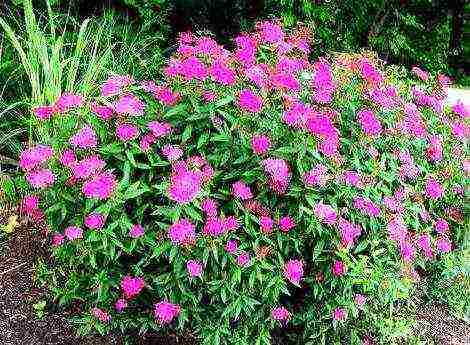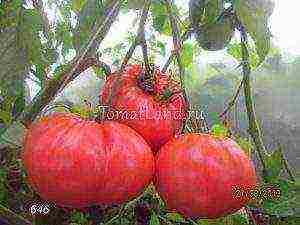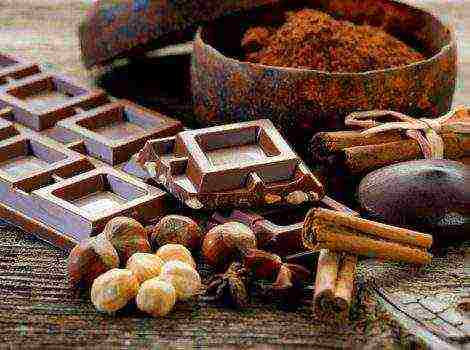Content
- 1 32 hybrid varieties of cucumbers from different companies
- 1.1 Main manufacturers in Russia
- 1.2 Only imported seeds
- 1.3 Hermann
- 1.4 Masha
- 1.5 Marinda
- 1.6 Xena
- 1.7 Slice King
- 1.8 Paratunka
- 1.9 Emelya
- 1.10 Grasshopper
- 1.11 Lord
- 1.12 Goosebump
- 1.13 Courage
- 1.14 Emerald earrings
- 1.15 Mother-in-law
- 1.16 Vanyusha
- 1.17 Espagnolette
- 1.18 Miracle-Khrustyk
- 1.19 Sugar baby
- 1.20 Champion Sedek
- 1.21 Spring
- 1.22 June early ripening
- 1.23 Tanik
- 2 Manufacturing company "Russian Garden"
- 3 Manufacturing company "Sedek"
- 4 Manufacturing company "Aelita"
- 5 Manufacturing firm "Gavrish"
- 6 Manufacturing company "Siberian Garden"
- 7 Manufacturing company "Seeds of Altai"
- 8 Review of the best varieties of cucumbers for greenhouses for 2017-2018
- 9 Cucumber varieties for greenhouses according to various characteristics
- 10 Reviews of gardeners about cucumbers for greenhouses for 2017-2018
Choosing the best hybrid cucumber varieties. The hybrids were bred by crossing two varieties. At the same time, the new variety receives only the best qualities from its predecessors.
In this article, we will compare the best places to grow cucumbers - open ground and a greenhouse. Everyone will find something interesting and useful for themselves. Some of the varieties of vegetables - as will be described in their description - are suitable for greenhouses and open ground. And the best I named and characterized those varieties of cucumbers that were personally tasted and approved, both in quality and yield, and in appearance. And all this, practically, regardless of the weather of the past years, but with the obligatory introduction of various kinds of fertilizers under the cucumbers, the fight against powdery mildew, similar ailments and so on. All data on the weight of the fruits and their size are absolutely real. But no matter how important the choice of the place for growing plants is, another aspect - whether we will buy a hybrid variety of cucumbers or not - is no less important, so we turn to it.
According to some seasoned gardeners-vegetable growers, non-hybrid varieties have two positive qualities: the ability to get their own free seeds and a more natural aroma of cucumbers. But hybrids have many advantages over simple varieties: they do not fall ill with downy mildew and other harmful infections, they practically do not release barren flowers, for the most part they do not need pollinators, they guarantee high harvests, they have dense pulp without large seeds (the list can be continued).

In modern vegetable growing, perhaps, there is no other such culture for which the advantage of hybrids over simple varieties of cucumbers would be so obvious. Russian amateur gardeners have picked up the global trend and prefer hybrids.Of course, some summer residents are afraid of imported hybrid seeds, suspecting their GMO origin, but leading breeders assure that traditional breeding methods are quite enough for successful hybridization of cucumbers.
In the description of the best varieties of cucumbers presented, you will often find variations from the word “parthenocarp "... In order not to scour the dictionaries and on the Internet I will inform you that all the charm of these varieties of cucumbers is represented in the formation of fruits in these vegetables without pollination at all. Hence it follows that these cucumbers either do not have seeds at all, or they are presented in small quantities, in the absence of embryos in them. From here, you will have a different taste. And, of course, this makes it wonderful and incomparable to grow these particular varieties of plants both in the greenhouse and in the open field.
I understand that I am already tired of the information on cucumbers, but a couple of things, in my opinion, are worth adding. Written below contains:
32 hybrid varieties of cucumbers from different companies
Main manufacturers in Russia
For the Russian seed market of private vegetable growing, cucumber seeds are supplied by several groups of producers. Imports are mainly represented by global corporations Monsanto and Sakata. Russian cucumber breeding successfully competes with foreign ones: Manul, Gavrish, Semko, Aelita, Sedek, Siberian garden, Russian vegetable garden, Altai Seeds produce and pack seeds for retail sales on their own. Its own selection is carried out in Siberia and other regions.
Only imported seeds
Hermann
This hybrid is more often counterfeited, which is the best proof of its popularity. Even reputable firms sin by deception. Genuine cucumber seeds must necessarily be expensive and be dyed green (although the color is already faked). If you put Herman down and were disappointed, it was not the real Herman. Genuine never disappoints.
Herman was created by the Dutch company Royal Slice, part of the Seminis concern, which recently merged into the world corporation Monsanto. Cucumber packages may have the name of one of these brands. The year of registration in the Russian seed register is 2001.
Parthenocarpic. Differs in the highest plasticity - that is, it is suitable for any climate and microclimate. The earliest of all begins to bear fruit (sometimes the previously announced 38 days) and lasts the longest. The resistance of vegetables to powdery mildew, mosaic, cladosporium is officially declared. In reality, it ignores downy mildew and has a certain resistance to root rot.
The growth of a bush in a plant can be described as average. Bunch ovary (up to 7 pieces). There is a simultaneous pouring of fruits - one at a time in several nodes. After harvesting, the next day, new green plants grow in the same nodes.
Cucumbers have an excellent presentation: dark, shiny. The white-spined tubercles are usually of medium size. The weight of each cucumber is about 80 grams, with a maximum length of 10 cm. The flesh in conservation is dense and crispy. There is never bitterness.
Masha
In the state register since 2000. The manufacturer is similar to Herman, to whom Masha is similar in many ways. The differences are manifested in appearance: Masha's cucumbers are several millimeters thicker and shorter, the tubercles are less common, light stripes are more pronounced. The branching of the plant bush is more moderate, slightly smaller than the foliage.
Marinda
It is a long-standing vegetable hybrid from the same manufacturer. It was declared in the Russian register almost a quarter of a century ago. It is still popular, although there are many fakes of it.
Self-pollinated. The harvest begins to be harvested on the fortieth day after germination. The plant is stress-resistant, with strong growth, not too leafy. 5 or even more embryos can form in one node. The cucumber greens are dense, not thick, the length fluctuates about 10 cm. The tubercles are rather large, slightly prickly, white-thorn. No bitter taste is observed. Marinda is very good pickled.
Xena
Partenocarpic lettuce type with smooth skin. This is a selection of the French branch of the Japanese corporation Sakata, and the seeds are produced in Chile.In the Russian register since 2009. This is a great example for outdoor cultivation in the south (best results achieved there!). Xena is the result of targeted selection for extreme heat tolerance.
Ripens early. Cucumber bushes are characterized by long growth, lateral branches are not too long. The fruits of vegetables reach a weight of 115-135 grams with a length of up to 16 cm. Plants do not get sick with powdery mildew, as well as peronosporosis, and are resistant to viruses.
The seeds must be treated with such a disease-fighting chemical (pesticide) as thiram.
Slice King
Another salad hybrid from Sakata, entered into the Russian register in 2009. This type of cucumber is called a slicer - an American salad cucumber. Slice King ("Salad King") grows in the open field, but is in dire need of pollinating insects. Almost does not form male flowers. Increases yield when replanting several non-hybrid varieties with male flowers. Pleases with an early period of entry into fruiting (from 37 days) and high resistance to various infections.
The fruit of a vegetable is inhibited in growth only when it reaches a length of 20 cm. It is covered with rare small tubercles, on which we will see light pubescence. Weight can be up to a quarter of a kilogram. By the type of greenery, tenderness of taste and aroma, they resemble our old popular hybrid of the Timiryazev Academy - Zozulya. It does not turn yellow for a long time, it does not flake for a long time after collection. The taste is very pleasant.
Russian seeds
Popular Semkovo cucumber hybrids - Temp and Paratunka - are safer to purchase in Semko branded packaging. When packing by other companies, counterfeits are possible and the yield is less than expected. But the seeds of the "Siberian Garden" are of good quality.
Manufacturing company "Semko"
Paratunka
This self-pollinated hybrid was declared in the state register in 2006. An important feature: the plant is not inhibited in the growth and yield of fruits, even under conditions of temperature changes. Withstands cladosporia, powdery mildew, bacteriosis. A bush of medium height, medium branching. Fruit picking begins on the fortieth day. Zelentsy keep an excellent presentation for a long time. They are all flat, standard size: 9 cm (plus or minus) cm, weight about 90 grams. The tuberosity is average, the pubescence is light. Canned cucumbers, sweet. At least two buckets per square meter can be obtained as a crop!
The breeders of the Manul company are the successors of the traditions of the Timiryazev Academy. They independently pack their seeds for retail sales and wholesale them for packaging to other companies. You should beware of fakes: the assortment is very popular. It is better to take packing with cucumber seeds from "Manul" itself or from other reliable companies.
Manufacturing company "Manul"
Emelya
This is an updated version of the Zozul hybrid while maintaining its merits. Parthenocarpik for any type of soil. In the Russian register since 2002. It adapts well to cool and cloudy weather. It stands out in that it is not affected by root rot. Early ripening (39 days), with a friendly loading of the harvest and early mass return. The fruits of cucumbers are sweet, thin-cored, for salad purposes. Fruit size up to 14 cm, 150 grams. The tubercles are sparse, the pubescence is light. Harvesting vegetables from a square in plantings is about two buckets.
Grasshopper
This self-pollinated hybrid was included in the registry in 2004. Early ripening (from 38 days). Bushes are long-leaved, not too branched. Shows excellent endurance to the main cucumber infections - peronosporosis, powdery mildew, clodosporium, viruses. Tuft ovary up to 6 pieces, with alternate filling. Top quality pickled products. The traditional size is 100 grams, 10 cm. The tubercles are white-spine, of medium size, rather densely located. Two buckets of zelents are obtained from a square meter.
Manufacturing company "Russian Garden"
Lord
Hybrid for open ground, unique in combination of features. Perfect for the regions of the Midland and northern regions. Included in the register in 2006 after serious tests.Medium in terms of the onset of ripening, yields a harvest, practically, before the onset of frost - due to cold resistance and immunity to all dangerous infections. Needs replanting of several non-hybrid plants with male flowers, or the presence of bees for pollination. Excellent yield is achieved due to massive growth of ovaries (main stem) on numerous lateral shoots. It is more convenient to grow vegetables in a sprout, without a garter. A node gives up to two or three cucumbers. They are bright, with small light stripes; tubercles with white pubescence, large, of medium density. They have an excellent cucumber flavor in salads and marinades.
The company "Gavrish" is actively involved in breeding work at the world level. Better to purchase branded packaging. All modern Gavrishev cucumbers are not bitter. Thanks to targeted selection, each hybrid has its own characteristic features, "its own face".
Manufacturing firm "Gavrish"
Goosebump
A rare feature for self-pollinated cucumbers is black spines. It is the trademark of high quality conservation. Fruits are of a beautiful presentation - dark, dense, with evenly spaced medium-sized tubercles, graceful. Weight 95 grams, length 12 cm. The bushes are powerful, with a dense leaf apparatus, medium branching, yield 7 kg. Ovary bunch up to 6 pieces. From the emergence of shoots to the first harvest, 43-45 days pass. The hybrid is resistant to root rot, olive spot. It does not spoil him (fortunately) with attention and peronosporosis with real powdery mildew. In the register since 2003.
Courage
The high cost of vegetable seeds pays off with an excellent harvest - a bucket from a bush. A self-pollinated plant is capable of the simultaneous growth of two dozen fruits. If you carry out pinching (remove the side branches), then not the usual 3-5 ovaries grow from each sinus of the main stem, but 10-12 pieces. The central lash is long. Quickly (from 40 days) enters into long-term fruiting. The length of the fruits removed - with dense pulp and weighing about 110-115 grams - sways about 12 cm. The hillocks are medium, rather densely set, white pubescent. The hybrid is not susceptible to viruses, cladosporia, powdery mildew and peronosporosis. The year of registration in the register is 2002.
Emerald earrings
The newest (2011) self-pollinated cucumber with a powerful branchy bush and numerous bouquet ovaries - up to 10 per node with decent nutrition and good lighting. Harvesting is possible in the stage of pickles, as well as gherkins. Limit sizes - 11 cm, 110 grams. Spines are light, rather densely spaced. The hybrid is resistant to all cucumber diseases. Begins to give zelents for 42 days, together, for a long time.
Mother-in-law
Contrary to popular belief, it differs significantly from the "pair" hybrid Zyatek. Listed in the register in the same year, Mother-in-law is distinguished by a more delicate taste (Zyatok is harder), a strong aroma, and has brown thorns. The plant begins to bear fruit, in contrast to the "relative" 4-7 days later, in a node of 3-4 greens. The recoil of Zelentsov is stretched. The infection resistance is excellent.
Firm "Aelita" packs a lot of cucumbers from different manufacturers, but also offers its own interesting selection of these vegetables. All of the patented hybrids presented below are self-pollinated, not bitter.
Manufacturing company "Aelita"
Vanyusha
Mid-season novelty (2010) for street beds with especially long-term fruiting. It has a comprehensive resistance to all infections. The bush is very branched, with a short main lash. It is more convenient to place the brace. The ovaries grow in bundles in a couple of three pieces. Cucumbers are short, elongated-oval, 85 grams each. Pulp without voids. Ideal for pickling, stocky. The surface is completely covered with white pubescent small tubercles (the so-called "German shirt").
Espagnolette
Selection of recent years (2013) for open ground. The term of entry into fruiting is average (55 days). The bush branches weakly, the growth energy is concentrated in the main stem. Resistant to disease. 2, sometimes 3 ovaries grow in the node.Small-bumpy greens by weight are closer to medium, 85-95 grams each, with light pubescence, excellent taste. The appointment is universal.
Miracle-Khrustyk
Early hybrid - 40 (plus or minus 2) days from the emergence of sprouts. Fruits are thin-skinned, fragrant, small (9 cm), small-bumpy, beautiful. Plants are disease resistant. The branching is medium, the main stem is vigorous. In knots up to 3 ovaries. Collection per square meter - more than 10 kg. In the register since 2006.
When the company "Sedek" packs vegetables not of its own selection, it raises many complaints. But their own production is not bad - both the best hybrid varieties of Chinese salad-type cucumbers, and patented canning gherkins - self-pollinated, without bitterness.
Manufacturing company "Sedek"
Sugar baby
Early (40 days) parthenocarpic with a bouquet ovary (up to 5 pieces) in some nodes. The products are leveled, transportable. 7 cm gherkins, with brown pubescence of large tubercles, with sweet and dense flesh. A bush of medium height, medium branching, with resistance to major diseases. Registration in the register - since 2010.
Champion Sedek
Included in the register in 2007. Recommended for Central and Siberia. Capable of simultaneous pouring of dozens of fruits, very productive. Begins the return on average (50 days). The plant bears fruit for a long time, is not afraid of infections and weather stress. Forms in each bosom up to 4 fruits weighing 70 gr. They are crispy with medium white-spiked tubercles. The branching of the bush is weak, the main lash is of moderate growth.
Spring
Very early (37 days) hybrid for frequent picking of gherkins and pickles. The return of the vegetable harvest is fast, friendly, and abundant. The growth of the bushes is low. They are not sensitive to powdery mildew - false and real. 7 cm gherkins, with small, not too thick brown pimples. They are all leveled, high-quality, sugary. Included in the register in 2006.
Manufacturing company "Siberian Garden"
June early ripening
New early parthenocarpic with the possibility of the first collection 42 days after germination. Scourges are powerful, of medium length, bundle ovary up to 4 pieces. Cucumbers are small, up to 10 cm. They are dark, with large tubercles, crisp, without bitterness. Producers promise the endurance of vegetables to bad weather and disease, high yield - up to three buckets per square meter.
Tanik
A unique parthenocarpic of Novosibirsk selection in the register since 2004. The plant is a bush type, with self-limiting growth and branching, with small foliage. Ultra-early ripening period. Possesses excellent resistance to bad weather, as well as infections - peronosporosis, powdery mildew, root rot, bacteriosis. Fruits are small - about 9 cm, 70 grams. Not prone to yellowing. Surface with infrequent large tubercles, black spines. Great in traditional salting.
Manufacturing company "Russian Garden"
Cruise
The bee-pollinated hybrid was created by a team of breeders led by A.A. Mashtakov (Rostov-on-Don). In the register since 1997. Recommended for open ground in the Volga region and the Caucasus. Resistant to drought, downy mildew and powdery mildew. Medium length bush with medium branching. Cucumbers 10 cm in size, 110 grams. They are black-spiky, sparsely lumpy, sweet, aromatic - excellent in traditional pickling (no vinegar). Excellent shelf life and transportability.
Manufacturing company "Sedek"
Friendly family
Greenhouse hybrid of medium height, moderate branching. On the central stem, up to 4 zelents grow at the nodes, on the lateral branches - a couple of times more. The ripening period of cucumbers is medium early (45 days). Pickles of 4 cm are collected from the bushes, gherkins of 7 cm, greens of 10 cm. The tuberosity is average, the spines are white. Resistance to true and downy mildew is excellent. The yield is surprising 20 kg per square. In the register since 2003.
Prestige
In the register since 2007. Zoned in Central Russia and Western Siberia. Suitable for outdoor use even in regions where unstable weather is considered the norm. But it follows from this that the greenhouse planting option will be much preferable.Vegetables are not afraid of shading, cloudy weather, cold snaps and diseases. It is also grown indoors. Early (from 42 days) enters fruiting and has a long-term impact. Medium-sized bush. Ovary in a bouquet of up to 4 pieces. Cucumber fruits-gherkins 8 cm long, weighing 70 g, excellent presentation. They are white pubescent, large-bumpy, dark green, without internal voids. The yield is high.
Manufacturing company "Aelita"
Ant
Very early (from 37 days) parthenocarpic for greenhouses and open ground. The lateral branches are short, ending in a bunch of ovaries. On the main stem in the axils, from two to seven fruits grow - their number directly depends on the lighting: less in the shade. Demanding only to the abundance of light, but hardy to any bad weather. Not susceptible to peronosporosis. Ignores mosaic virus, downy mildew, avoids cladosporia (olive spot). The fruits of the plant are large-lumpy, white-thorny, slightly ribbed, with small white stripes, up to 11 cm in size and 110 grams. In the register since 2003.
Funny gnomes
New (2013) early ripening hybrid (38 days). Disease resistance is average. The main lash is long, branching is weak. Lovers can choose a greenhouse, or plant it in open ground with a trellis. Zelentsov in the bosoms of 3-4 pieces, they are dark green juicy color, small - 8 cm, 80 grams. Small tubercles are very densely located. Cucumbers are good at preservation. Presentation and excellent yield are guaranteed.
Manufacturing firm "Gavrish"
Berendey
The main "trick" is the ability of vegetables to bear fruit when shaded, which, in combination with parthenocarp and resistance to root rot, makes it possible to harvest even in an apartment. In greenhouses, cucumbers also show themselves well, giving out fruits from a bush to a bucket. In knots, as a rule, 3-4 ovaries are tied. The size of the zelents is 14 cm, 135 grams. They are white pubescent, with beautiful tubercles. The purpose is mainly salad, although the hybrid is also suitable for pickling. Medium early (44-50 days). Registered in the register in 2007.
Garland
A newer version (2010) of a shade-tolerant self-pollinating hybrid with the highest tolerance to all cucumber diseases. Cultivated in indoor conditions, greenhouses; succeeds in the open air. The main lash is long, branching is very weak. Bouquet ovary - 4-5 pieces. Zelentsi are dark, lumpy, with light pubescence, dense, downy. They grow up to 13 cm, 125 grams. The appointment is universal.
Son-in-law
The most popular parthenocarpic for picking pickles, gherkins, traditional zelents (11 cm, 95 grams). Excellent taste. Cucumber tubercles are rather dense, beautiful, white-pubescent. Each node grows from 2 to 8 zelents. The yield of vegetables is high. Fruiting from 45 (plus or minus 3) days from the emergence of sprouts and for a long time. Does not suffer from powdery mildew (both false and real), root rot. My recommendations for growing it both in the greenhouse and in the open field. In the register since 2007.
Break
This self-pollinated cucumber hybrid has been on the registry since 2002. Recommended for greenhouse crops, but also gave excellent results outdoors. Medium height, medium branched. On the main stem, it forms a pair or three of ovaries in the axil of each leaf, on the branches - up to 8 pieces. The bush gives a bucket harvest. This is facilitated by endurance to the most harmful infections - peronosporosis, powdery mildew, root rot. Zelentsy 10 cm in size, 90 grams, excellent in conservation. They are often lumpy, with light spines of medium size.
Manufacturing company "Siberian Garden"
Pace
The hybrid has been declared in the Russian Register since 2006 and has a state patent as an outstanding breeding achievement. Parthenocarpic for growing pickles (size varies around 5 cm) and gherkins (up to 7 cm). Zelentsy do not outgrow, but require regular harvests to actively increase the yield. Exit from a square meter - a bucket of pickles or two buckets of gherkins. Cucumbers are lumpy, prickly, white-thorn, without voids inside.The main advantage is the impeccably dense and crispy flesh of pickled products; the seeds are not felt. There is no bitterness.
The plant is tolerant to extremely high greenhouse temperatures, but also in the open field shows excellent results in terms of yield. Bunch ovary from three pieces. It is characterized by long-term growth. Branching in plantings is very weak. Early and "long-lasting": picking of vegetables begins 42 days after germination and continues until the end of the season (provided that the growth point of the central stem is maintained). Does not fall ill with cladosporiosis. Real and downy mildew, and the cucumber mosaic too, practically does not "touch" him.
Manufacturing company "Seeds of Altai"
Seven kids
Self-pollinated early maturing (42 days) novelty from Siberian and Altai producers. Gherkins and zelents - this is at what stage in the development of cucumbers this hybrid is excellent for harvesting. You will be delighted with 90 gram fruits and the length of removal is 11 cm. Cucumbers are even, lumpy, with light pubescence. Stable fruiting in all greenhouses. The appointment is universal.

Packaged seeds catalog (pdf)
- View catalog
Cucumber seeds
When choosing varieties of cucumbers for growing in greenhouses and greenhouses, you need to pay attention to several parameters. All of them have an impact on the final result - the harvest. Below we will consider the features of selection, and also give the best varieties of cucumbers for greenhouses for 2017-2018 according to gardeners' reviews.

Indoors, 3 groups of modern varieties can develop normally:
- Hybrids with 100% parthenocarp (fully self-pollinated) are the most successful option.
- Hybrids of the female type of flowering (with a predominance of female flowers) are more suitable for semi-open greenhouses; it is advisable to plant several bushes with male flowers to them (for better pollination).
- Chinese variety - hybrid and varietal (non-hybrid) forms. They tolerate temperature contrasts very well. Appointment - mainly salad.
Is it possible to plant different varieties of cucumbers in one greenhouse? Experienced vegetable growers answer this question in the affirmative. It is not recommended to give preference to only one variety, for reliability it is better to plant at least 2-3, from different companies.
 Benefits of hybrid greenhouse cucumbers
Benefits of hybrid greenhouse cucumbers
Selection factors for specific varieties:
- We purchase seeds only from the most reliable companies.
- Almost all modern hybrids do not taste bitter, and this feature is not always mentioned on labels now, this is implied by itself. Bitterness can appear in old varieties or in vegetables from unscrupulous producers.
- Pay attention to the timing of the return of the crop: fast and friendly or extended.
- We calculate in advance the required amount of salad and gherkins.
- The degree of bumpiness ("shirt") is a matter of personal taste. Breeders offer many different options.
- If it is not possible to pay much attention to planting, cucumbers with restrained lateral branching that do not require shaping will help out (these also exist now).
- There are special hybrids for shaded areas.
- Preference should be given to forms with maximum resistance to various infections.
It should be remembered that modern breeding has achieved tremendous success in the field of disease resistance of cucumbers, but they are still susceptible to attacks by insect pests (greenhouse whitefly, spider mites, melon aphids, etc.).
Review of the best varieties of cucumbers for greenhouses for 2017-2018
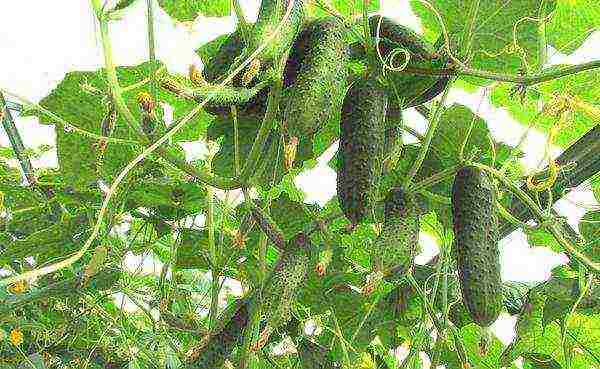
For polycarbonate greenhouses
Polycarbonate greenhouse cucumber varieties are selected with the longest fruiting period and maximum tolerance to pathogens.
Herman F1
One of the most popular cucumber hybrids (beware of fakes!). Dutch selection. Stable and reliable. It bears fruit perfectly in any greenhouses and in the open air. Not afraid of heat, cold snap and disease. One of the first to bear fruit and one of the last to finish.
Bunch ovary (up to 7 pcs.), With simultaneous filling of several fruits in different nodes. Cucumbers are lumpy, strong, medium-sized, high quality, excellent presentation.
Maryina Roshcha F1
Selection of the Russian company "Manul" (Timiryazev Academy). An early hybrid with a long period of fruit formation.
It is not affected by dangerous diseases, including root rot and downy mildew.
Parthenocarp is very pronounced, the ovaries grow actively in any conditions (extreme temperatures, lack of sunlight). One node contains up to 5 pieces. At the same time, more than a dozen zelents can be poured on the bush - large-lumpy, 11 cm in size.
Masha F1
A very early Dutch hybrid with massive early recoil. Moderate branching, the bushes do not thicken. Disease resistance is good. Zelentsy 8 cm, dark, with rather sparse tubercles.
Pace F1
Early ripening (37-42 days) gherkin from the Semko firm. Does not suffer from peronosporosis and other destructive diseases. Light-loving, slightly branched. In a knot there are up to 5 ovaries. Pickle output - 10 kg / sq. m., gherkins - more than 20 kg. The density of the pulp is the highest, the seeds are not felt.
Shchedryk F1
A hybrid from the Russian company "Gavrish" with the entry into fruiting on the 45th day. Tolerant to root rot, peronosporosis. There are 5-8 ovaries in a knot. Cucumbers grow up to 10 cm; the tubercles are large, white-spined. Recoil from a bush - more than 6 kg.
Many vegetable growers prefer to grow this heat-loving vegetable in carbonate greenhouses, where the optimum temperature and humidity are created. The only serious problem is the risk of the rapid spread of harmful insects. You have to be on the lookout all the time.
For foil greenhouses and greenhouses
The best varieties of cucumbers for a greenhouse that is covered with a film must be resistant to sudden temperature changes. It is advisable to select vegetables for greenhouses with genetic resistance to root rot.
In low greenhouses, short-stemmed (bush) forms are convenient.
Adam F1
Mid-early (45 days) Dutch hybrid of the new generation. It is not affected by peronosporosis and other pathogens. The recoil is long-term, uninterrupted. Cucumbers no more than 95 g, very strong; surface with small tubercles. The appointment is universal.
Courage F1
Selection of the Russian company "Gavrish". Fruiting begins one and a half months after germination. The bush is powerful, with a bundle ovary (2-6 pieces), the load of the crop is more than 7 kg. Lumpy cucumbers, size 120 g. Disease resistance - complex.
Okhotny Ryad F1
Super early parthenocarpic from the Manul firm, resistant to peronosporosis and other diseases. Restrained branching. Cucumbers are sparsely lumpy, 8 cm in size. Tufted ovary - up to 6 pieces.
According to my desire F1
Mid-season hybrid of the St. Petersburg company "Biotekhnika" from a series of so-called "single-stem" - with extremely short lateral branches. Does not require shaping.Tolerant to shading, cold snaps. There are 3-4 ovaries in the knot. Zelentsy are sparsely lumpy, crispy.
Miracle toddler F1
A novelty presented by the "Aelita" company. Plants enter fruiting early (38 days from the beginning of the growing season), are distinguished by powerful growth and long-term growth of bundle ovaries. White-thorn cucumbers, 80 g in size, with large tubercles. Productivity - up to 15 kg / sq. m.
Gardeners note that many modern cucumber hybrids grow well even in the simplest, uncomplicated greenhouses. Plants withstand any whims of bad weather with honor.
For autumn-winter cultivation
Special hybrid varieties for the winter greenhouse are resistant to lack of sunlight. Zelentsy are growing large, their purpose is salad.
F1 Olympics
Mid-season hybrid selection "Manul" for winter greenhouses. Long-term recoil on lateral shoots: yield reaches 45 kg per sq. meters. Demonstrates high adaptability. The root system is not subject to decay. Fruits are 18 cm in size, lumpy, white-thorn.
Offers from the company "Semko"
- Ararat F1... Smooth-fruited hybrid with greens weighing up to 150 g. Plants show resistance to downy mildew and stress. Recoil - up to 250 kg from 10 sq. m.
- Sapsho F1... A mid-season hybrid that begins to bear fruit 2 months after germination. In each node, 1-3 fruits 15 cm in size are formed, with medium-sized tubercles. The output of marketable vegetables per square meter is more than 20 kg.
- Tatiana F1... The cucumber is mid-season, long-leaved .. The size of the green is 17 cm, 140 g. The tubercles are prickly. General collection from 10 sq. m - 240 kg and more.
Self-pollinated (parthenocarpic)
Almost all modern varieties of greenhouse cucumbers are self-pollinated. They produce only female flowers, and their ovaries grow to the size of green plants even without the access of pollinating insects.
In this case, full-value seeds are not formed.
Heroic Strength F1
Selection of the agricultural firm "Manul". Very early gherkin, with complex infection resistance. Long-term yield on lateral branches. There are 8 or more ovaries in a knot. Cucumbers are lumpy, pubescent, 8 cm in size.
Son-in-law F1
Popular parthenocarpic from the Gavrish company. Comes into fruiting one and a half months after germination. At the nodes, from 2 to 8 zelents 10 cm in size are formed (can be collected at the stage of pickles and gherkins).
Valuable quality - hardiness to downy mildew and powdery mildew, root rot, weather stress. One bush gives up to 7 kg of products.
Claudine F1
An early maturing Dutch hybrid with high quality small tuberous greens. Fruit weight - up to 85 g. Bushes are medium-sized, disease-resistant, fruitful.
Blizzard F1
Early ripening parthenocarpic from Biotekhnika. The lateral branches are short. Fruits are small - 65 g, 7 cm. In one node - 3-4 ovaries. The hybrid withstands waterlogging in the root zone, does not get sick with real and downy mildew.
Prestige F1
Popular gherkin of the Zedek selection. Resistant to diseases, temperature stress, shading. Entry into fruiting - from 42 days. The fruits are pimply, neat, dense, no more than 8 cm in size. The yield is long, at the end of the season - up to 25 kg per square meter.
Early
Early varieties of cucumbers are divided into two categories - with "hurricane" fruiting (rapid, massive formation of the crop) and long-term gradual return.
Blizzard F1
A very early (from 37 days) hybrid from the St. Petersburg firm "Biotekhnika". Not susceptible to damage by downy mildew and powdery mildew. Lateral branching is restrained. There is a simultaneous pouring of more than a dozen fruits; their size is 7 cm.
Maresa F1
Novelty of the Dutch selection; comes into fruiting 38 days after germination. High yield and disease resistance. Cucumbers are small, leveled, of excellent presentation.
Masha F1
Very early (from 36 days) gherkin from Holland with amicable return early.Cucumbers are very dense, 8 cm long, even, dark. Excellent resistance to pathogens, consistent harvest every summer.
Meringue F1
High-yielding Dutch hybrid with uniform marketable cucumbers. Zelentsy are large tuberous, dense. Fruiting begins 37 days after the beginning of the growing season.
Uranus F1
Ultra-early (36 days) novelty from the Japanese corporation Sakata. The plant is cold-resistant and heat-resistant. Cucumbers of a uniform green color, weighing 90 g. Salting qualities are very high.
According to the reviews of most gardeners, early ripening varieties are considered the most attractive.
However, not everyone likes that by the end of the season they have already completed fruiting. That is why it is necessary to give space to mid-late cucumbers. And recently, early maturing hybrids with a very long yield have appeared.
Beam varieties
The varieties of bunch cucumbers are very productive, but they have high nutritional requirements, and some also have bright lighting.
Friendly family F1
Popular gherkin from the Gavrish company. The yield of the crop begins one and a half months after germination. In the nodes of the lateral branches, 7-8 ovaries are laid. The recoil is massive, the disease resistance is at the highest level.
Square dance F1
Early parthenocarpic from the Gavrish firm. The ovary on the main stem is of a bouquet type (up to 10 per node). The fruits weigh 90 g each, they are strong, with large tubercles. The bushes are resistant to cold snaps, do not get sick with downy mildew and powdery mildew.
The output from one plant is more than 6 kg.
Magdalena F1
Dutch novelty for the production of pickles and gherkins with the highest pulp density. The color is saturated. In the nodes, 7 zelents are poured. The hybrid successfully resists attacks from pathogens and temperature stresses.
Beam Charm F1
The newest Russian hybrid from the Aelita company. A bouquet ovary can produce 10-12 tuberous greens.
Miracle bouquet F1
Harvesting novelty of the selection "Gavrish". At the same time, more than three dozen fruits grow on the bush, in bunches of 3-5 pieces. The age of entry into fruiting is from 42 days. Disease resistance - up to date. The yield is long lasting.
Amateur vegetable growers note that the potential of superbeam hybrids is successfully realized only with abundant feeding and good water supply.
Cucumber varieties for greenhouses according to various characteristics
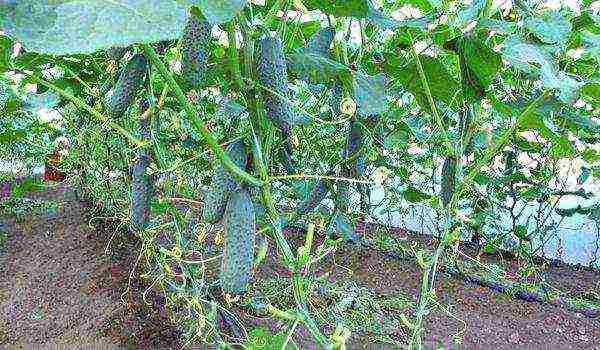
The most productive
The most productive varieties of cucumbers for a greenhouse combine several valuable features: early maturity and a long fruiting period, bundle ovary and genetic resistance to infections.
- Herman F1
- Courage F1
- Marinda F1
- Prestige F1
- Pace F1
- Ecole F1
Sustainable
High resistance to disease and weather stress is an essential requirement for modern cucumber culture. Labor and financial costs for chemicals are reduced, yields and ecological cleanliness of vegetable products are increased, and pesticide load on the environment is minimized.
- Barvina F1
- Stay healthy F1
- Great Caesar F1
- Kyoto King F1
- Trump F1
- Focus F1
- Eskimo F1
For pickling and canning
For canning (blanks with vinegar), any cucumbers with dense pulp and small seeds are suitable. It is desirable that they are not prone to rapid overgrowth and thickening ("paunchy").
With the classic (old) version of pickling without vinegar, black-spiked cucumbers are considered the most suitable (the choice of such hybrids, unfortunately, is limited).
- Spring F1
- Crocodile F1
- Goosebump F1
- Robin Hood F1
- Mother-in-law F1
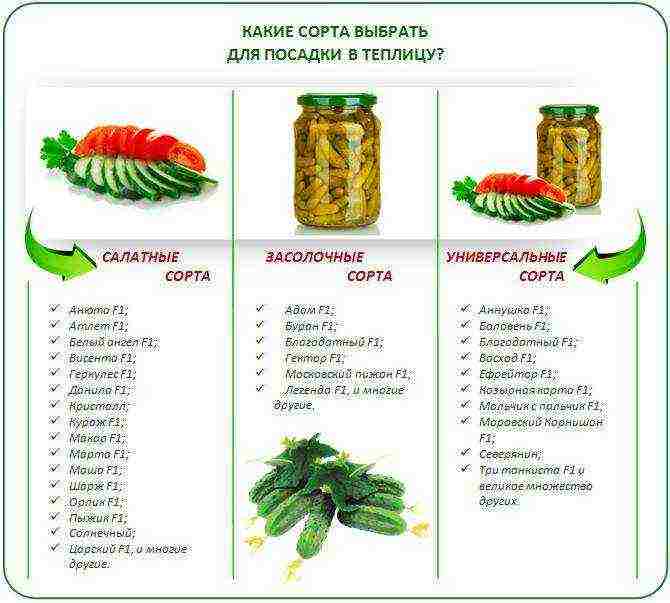
Gherkins
Gherkin varieties are a special breeding line. For the production of pickles and gherkins, special hybrids have been bred.
- Baby Mini F1
- Sankin love F1
- Son of the F1 Regiment
- Pace F1
- Ecole F1
Varieties by origin
Dutch varieties
Holland is the world leader in hybrid cucumber breeding. Special attention is paid to the complex resistance to infections. The assortment is designed for every taste. As a rule, Dutch cucumbers have a strong (even tough) rind.
Varieties: Claudine F1 (updated Claudia F1), Madita F1, Mila F1, Monisia F1, Cartridge F1
German varieties
The classic "German shirt" is a finely bumpy surface of the fruit. Such cucumbers have an excellent presentation and are good for pickling. Popular old hybrids (Libelle F1, Moringa F1, Ira F1, Rita F1) are bee-pollinated.
Germanic parthenocarpics may be more or less spiny, but they still show high quality zelents.
Varieties: Harmony F1, Ginga F1, Dirigent F1.
Chinese varieties
Chinese long-fruited cucumbers are a special variety. It is attracted by the excellent taste of salad orientation - thin skin, fragrant pulp. Pleases with excellent, stable yield and a high degree of adaptability to various weather conditions.
Varieties: Serpent Tempter F1, Emerald Stream F1, Chinese Gin F1, Chinese Serpent (not hybrid), Beijing Delicious F1.
Cucumber varieties for regions
For the Middle Lane: Walk, Russia! F1, Paratunka F1, Russian motives F1, Russian style F1, Russian feast F1.
For the Moscow region: Arbat F1, Connie F1, Moscow delicacy F1, Moscow salad F1, Moscow evenings F1.
For the Leningrad region: Bimbo-Star F1, Joulupukki F1, Karelian cones F1, Lapland F1, St. Petersburg Express F1.
For Siberia: Ob emeralds F1, Nord Stream F1, Siberian bouquet F1, Siberian speed walker F1, Siberian express F1.
For the Urals: Everyone envy F1, Our granddaughter F1, RMT F1, Uralochka F1, Uralskiy gherkin F1.
Reviews of gardeners about cucumbers for greenhouses for 2017-2018
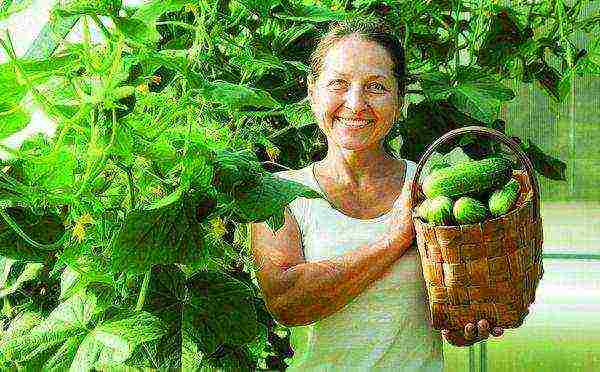
For cultivation in a greenhouse, it is recommended to choose parthenocarpic (in which fruit ovaries pass without pollination) or self-pollinated cucumber varieties.
This will allow you not to worry about attracting bees to the greenhouse by additional replanting of flower plants or spraying cucumbers with infusions of honey or jam.
According to their purpose, cultivated cucumbers can be divided into:
- salad;
- salting;
- universal.
We will define in each of these categories the varieties that received the best reviews from specialists and gardeners in 2017.
The best salad varieties
Cucumbers intended for fresh consumption should be slightly sweet in taste, without bitterness, tender and crunchy. According to many reviews, the following hybrid varieties have such qualities:
- Courage F1;
- Martha F1;
- Tsarsky F1;
- Orlik F1.
"Yielding, very tasty cucumbers", "Do not get sick, all summer with cucumbers" - typical statements about these varieties.
The best varieties for pickling
For pickling, cucumbers with a dense consistency, small sizes and with a skin that does not prevent the penetration of salt into the fruit are better suited. According to reviews, the following varieties and hybrids fully meet these requirements:
- Vyaznikovsky;
- Altai;
- Great F1;
- Moscow dude F1.
“Beautiful, even fruits”, “Pickled cucumbers turned out to be firm and crispy, very tasty” - these are the impressions consumers share about these varieties.
The best universal varieties
Cucumbers of these varieties should be good to eat both fresh and after heat treatment (canning). Many good reviews have received such varieties as:
- Finger boy F1;
- Moravian gherkin F1;
- Northerner;
- Blessed F1.
The list of these wonderful varieties is far from being exhausted. In each of the categories of cucumbers (salad, pickling, universal) there are other good varieties that are in no way inferior to those listed.
Additional recommendations for choosing a variety of cucumbers for greenhouses
For cultivation in a greenhouse, it is better to opt for hybrids (often also called hybrid varieties). Their main advantage over traditional varieties is that they are resistant to all types of diseases.
This is especially important for greenhouses, in which greenhouse (sorry for the tautology) conditions are created not only for the cultivated crop, but also for various fungal diseases and pathogenic bacteria.
This resistance, coupled with high yields and ease of maintenance, fully compensates for the increased costs of seeds. To distinguish a hybrid variety from a regular variety, seed producers add the combination F1 after its name.
Good harvests to you!
